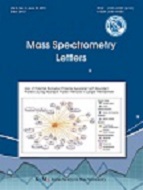
- P-ISSN 2233-4203
- E-ISSN 2093-8950

The formation of zinc finger peptide−Zn2+ complexes in electrospray ionization mass spectrometry (ESI-MS) wasexamined using three different metal ion sources: ZnCl2, Zn(CH3COO)2, and Zn(OOC(CHOH)2COO). For the four zinc fingerpeptides (Sp1-1, Sp1-3, CF2II-4, and CF2II-6) that bind only a single Zn2+ in the native condition, electrospray of apo-zinc fingerin solution containing ZnCl2 or Zn(CH3COO)2 resulted in the formation of zinc finger−Zn2+ complexes with multiple zincions. This result suggests the formation of nonspecific zinc finger−Zn2+ complexes. Zn(tartrate), Zn(OOC(CHOH)2COO),mainly produced specific zinc finger−Zn2+ complexes with a single zinc ion. This study clearly indicates that tartrate is an excellentcounter ion in ESI-MS studies of zinc finger−Zn2+ complexes, which prevents the formation of nonspecific zinc finger−Zn2+complexes.
Fenn, J. B. (1989). . Science, 246, 64-.
Katta, V. (1991). . J. Am. Chem. Soc, 113, 8534-.
Lim, H. K. (1995). . J. Mass Spectrom, 30, 708-.
Cheng, X. (1995). . J. Am. Chem. Soc, 117, 8859-.
Loo, J. A. (1997). . Mass Spectrom. Rev, 16, 1-.
Rostom, A. A. (1999). . Curr. Opin. Struct. Biol, 9, 135-.
Oh, H. B. (2002). . Proc. Nat’l. Acad. Sci. U.S.A, 99, 15863-.
Lee, S. Y. (2009). . Int. J. Mass Spectrom, 279, 47-.
Yeonmi Seong. (2011). An anomalous dissociation of protonated cluster ions of DNA guanine-cytosine base-pair. Mass Spectrometry Letters, 2(3), 73-75.
Hutchens, T. W. (1992). . Febs Lett, 309, 170-.
Hu, P. F. (1994). . Anal. Chem, 66, 4190-.
Feng, R. (1995). . J. Am. Soc. Mass Spectrom, 6, 1105-.
Cheng, X. (1995). . J. Am. Chem. Soc, 117, 8859-.
Rostom, A. A. (2000). . J. Mol. Biol, 296, 269-.
Kempen, E. C. (2000). . Anal. Chem, 72, 5411-.
Wang, W. (2003). . Anal. Chem, 75, 4945-.
Gabelica, V. (2003). . J. Mass Spectrom, 38, 491-.
Speir, J. P. (1995). . J. Mass Spectrom, 30, 39-.
Toli , L. P. (1998). . Anal. Chem, 70, 405-.
Yi, S. (2007). . Biochemistry, 46, 13120-.
Niessen, W. M. (1999). . J. Chromatogr. A, 856, 179-.
Cavanagh, J. (2003). . Anal. Chem, 75, 3281-.
Pan, J. (2009). . Anal. Chem, 81, 5008-.
Miller, J. (1985). . EMBO J, 4, 1609-.
Jamieson, A. C. (2003). . Nature Reviews Drug Discovery, 2, 361-.
Park, S. J. (2011). . Analyst, 136, 3739-.
Kriwacki, R. W. (1992). . Proc. Nat’l. Acad. Sci. U.S.A, 89, 9759-.
Hsu, T. (1992). . Science, 257, 1946-.
Gogos, J. A. (1996). . Proc. Nat’l. Acad. Sci. U.S.A, 93, 2159-.